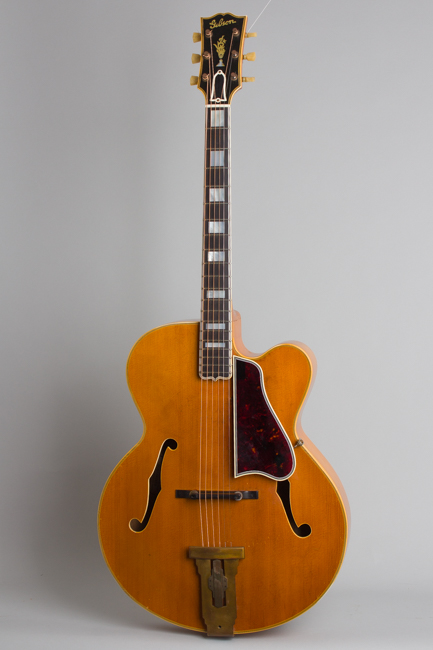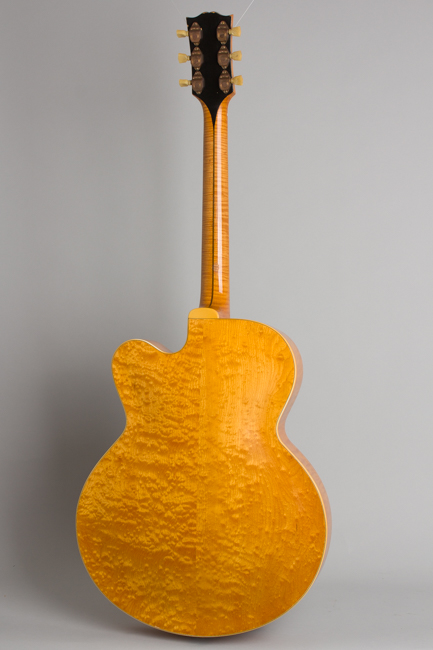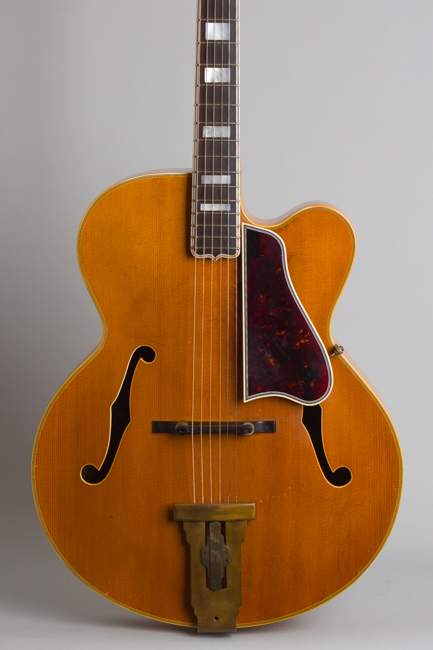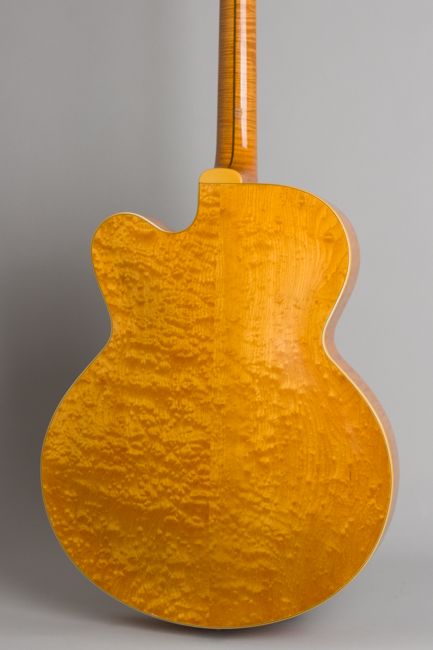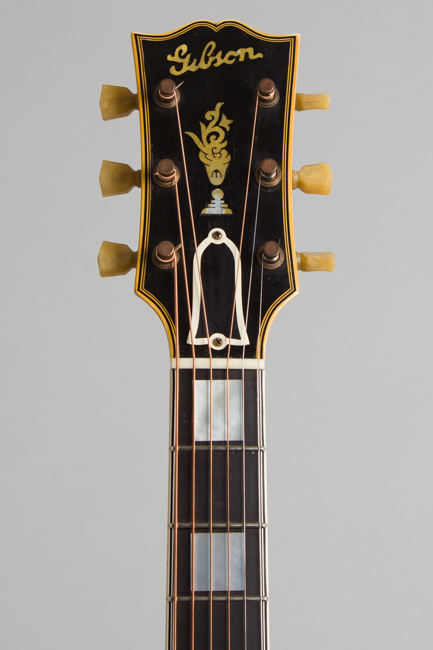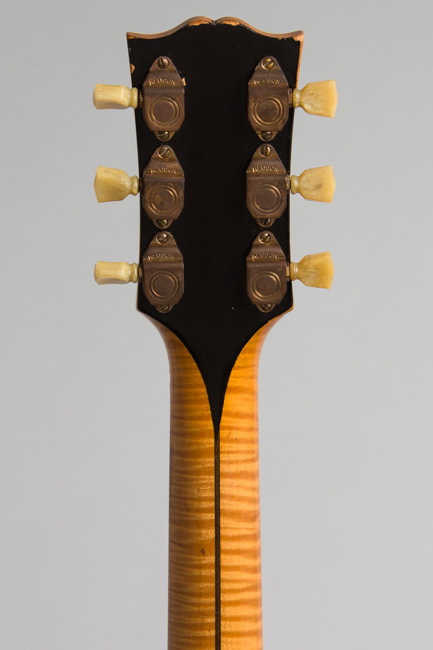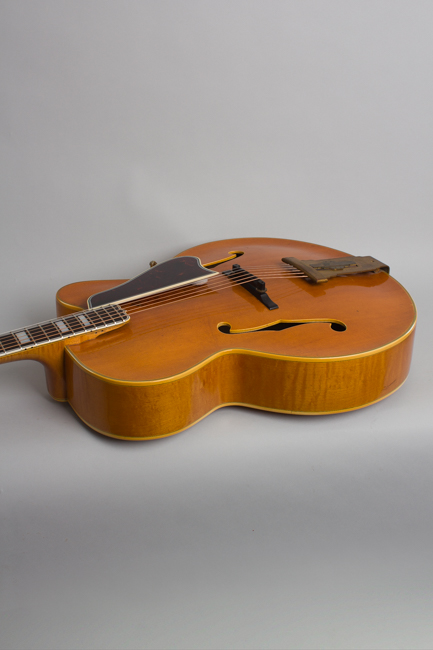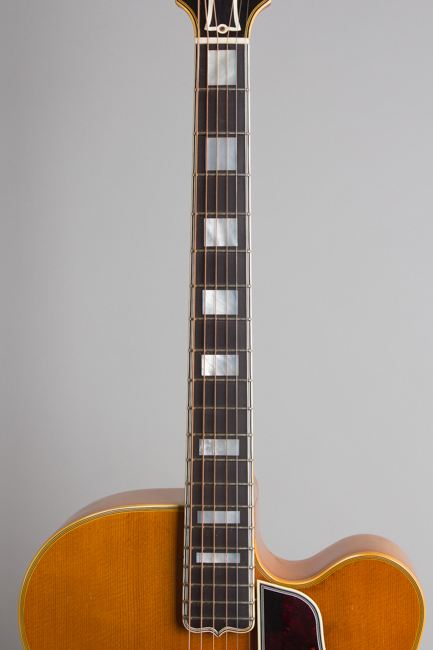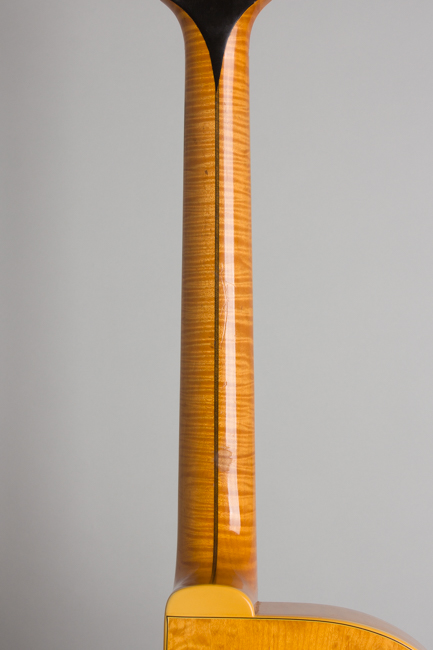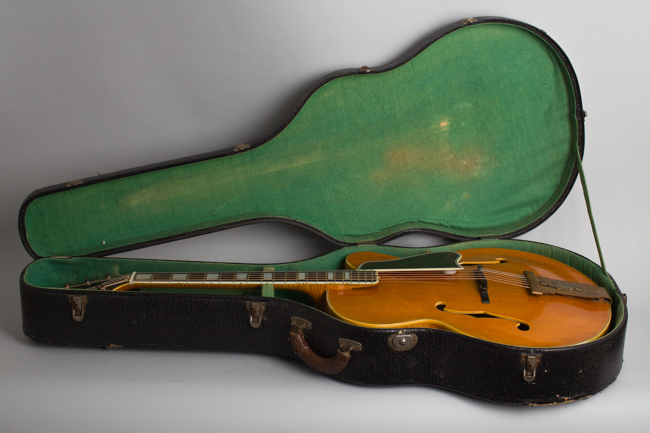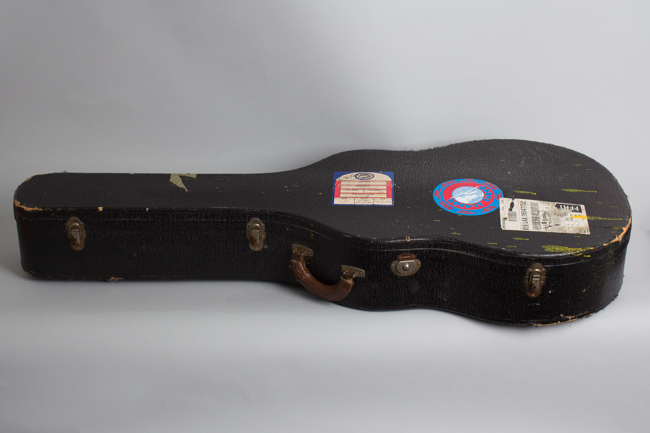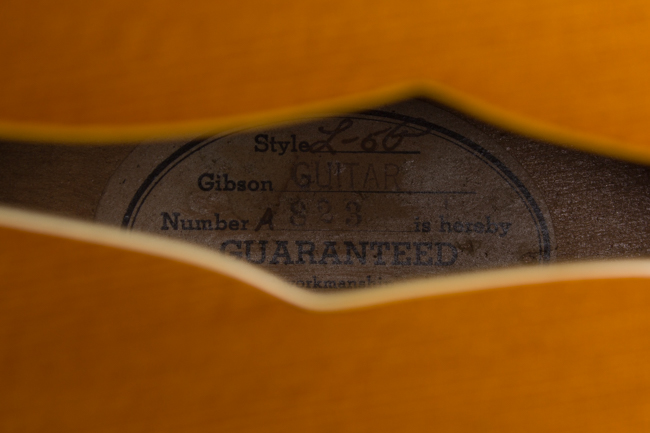Gibson L-5 PN Arch Top Acoustic Guitar (1947)
Item # 12902
Prices subject to change without notice.
Gibson L-5 PN Model Arch Top Acoustic Guitar (1947), made in Kalamazoo, Michigan, serial # A-823, natural lacquer finish, flame maple back and sides with spruce top; laminated maple neck with ebony fingerboard, original black hard shell case.
This is a beautiful very early postwar blonde Gibson L-5P, one of the very first ones made when production of these high-end carved-top guitars resumed in later 1947. The very early 3-digit "A" serial number on the white "Artist" label dates to around October '47. No L-5's were registered as shipped that year but Gibson's immediate post-war records are sketchy, so it may well have left Kalamazoo before year's end. If not then it would be one of the 21 listed as shipped in 1948. In any case they did NOT build a whole lot of these!
The company's "Premier" L-5 and Super 400 had been announced in the 1940 "Catalog AA" but not many were shipped before the US entry into WWII brought production to a halt. "Premier" designated a cutaway guitar, still a fairly new idea in 1947 and a major Gibson innovation that was widely imitated. Estimates indicate that only around 53 natural-finish, cutaway L-5's were shipped up through 1943; this 1947 would be one of the first postwar examples. The "Premier" was dropped the next year in favor of the more prosaic "cutaway" designation; this one is still labeled as "L-5P". Original L-5 Premiers like this one represent some of the finest purely acoustic cutaway archtops the Gibson company ever built.
This guitar's multi-bound headstock still features the old 1930's script "Gibson" logo that was about to be discontinued, replaced by the new, now-familiar block logo. This is likely an old stock pre-WWII headstock veneer getting used up! The multi-bound, pearl-block inlaid fingerboard is ebony; some L-5's from this period used Brazilian rosewood instead, apparently around 1948-9 Gibson experienced an ebony shortage. The multi-bound top and beautiful burled maple back feature a natural lacquer finish that has aged to a lovely amber hue. The round back neck is laminated maple with some dashing flame figure as well. The tuners are gold-plated Kluson Sealfasts with translucent celluloid "keystone" buttons, a feature in place since 1940. In this period the L-5 was second to the 18" Super 400 in Gibson's line, but many players have always preferred the easier to handle 17" body and then and now it was considered a top professional choice.
The top on this example is carved somewhat thinner than many period L-5's making for a very lively sound with plenty of power and projection. At the time this guitar was built the top-line "Orchestra Guitars" were still more important to the Gibson company than flat tops or even electrics, although over the next few years that market would grow exponentially. The 1947 the return of this model to production was a definitive statement of Gibson's post-war resurgence. This is a truly splendid example of a late swing-era L-5P, an excellent playing and sounding guitar and simply as classy as it gets.
Overall length is 42 1/4 in. (107.3 cm.), 17 in. (43.2 cm.) wide at lower bout, and 3 3/8 in. (8.6 cm.) in depth, measured at side of rim. Scale length is 25 1/2 in. (648 mm.). Width of nut is 1 11/16 in. (43 mm.).
This nearly 80 year old guitar remains in lovely original condition both structurally and cosmetically, showing general wear from play but no major damage or repair. There is some general checking to the finish (most heavily on the back) and scattered scuffing, dings, chips and scrapes to the body, but really this is a relatively clean guitar for its age. The back of the neck has very little noticeable wear through the finish, most noticeable a worn-through spot behind the 10th fret. Apart from this there are just a few small scratches, dings and dents; the neck is carved slimmer than some and feels fantastic.
There are no visible crack repairs. The bridge was replaced (looks like long ago) with a beautiful hand-carved ebony unit that appears to be the work of John D'Angelico; it is certainly in his style even if not be his hand. The original pickguard disintegrated some time ago; a correct Paul Fox repro pickguard is fitted with some outgassing stains to the top visible underneath it. The gold plating on the instrument shows some fairly heavy wear overall, especially the tailpiece which has tarnished noticeably. The guitar has been refretted with appropriate wire but the fingerboard binding was cut through at the time. The typical small "Vampire bites" on bass side of the fingerboard extension from old DeArmond pickup installation are visible.
This guitar is a truly excellent player with a big, incisive sound that retains plenty of warmth underneath -- a serious swing-era classic. It is housed in the original 17" just-post war green-lined Hard case and still has many more decades of music ahead of it. Overall Excellent - Condition.
This is a beautiful very early postwar blonde Gibson L-5P, one of the very first ones made when production of these high-end carved-top guitars resumed in later 1947. The very early 3-digit "A" serial number on the white "Artist" label dates to around October '47. No L-5's were registered as shipped that year but Gibson's immediate post-war records are sketchy, so it may well have left Kalamazoo before year's end. If not then it would be one of the 21 listed as shipped in 1948. In any case they did NOT build a whole lot of these!
The company's "Premier" L-5 and Super 400 had been announced in the 1940 "Catalog AA" but not many were shipped before the US entry into WWII brought production to a halt. "Premier" designated a cutaway guitar, still a fairly new idea in 1947 and a major Gibson innovation that was widely imitated. Estimates indicate that only around 53 natural-finish, cutaway L-5's were shipped up through 1943; this 1947 would be one of the first postwar examples. The "Premier" was dropped the next year in favor of the more prosaic "cutaway" designation; this one is still labeled as "L-5P". Original L-5 Premiers like this one represent some of the finest purely acoustic cutaway archtops the Gibson company ever built.
This guitar's multi-bound headstock still features the old 1930's script "Gibson" logo that was about to be discontinued, replaced by the new, now-familiar block logo. This is likely an old stock pre-WWII headstock veneer getting used up! The multi-bound, pearl-block inlaid fingerboard is ebony; some L-5's from this period used Brazilian rosewood instead, apparently around 1948-9 Gibson experienced an ebony shortage. The multi-bound top and beautiful burled maple back feature a natural lacquer finish that has aged to a lovely amber hue. The round back neck is laminated maple with some dashing flame figure as well. The tuners are gold-plated Kluson Sealfasts with translucent celluloid "keystone" buttons, a feature in place since 1940. In this period the L-5 was second to the 18" Super 400 in Gibson's line, but many players have always preferred the easier to handle 17" body and then and now it was considered a top professional choice.
The top on this example is carved somewhat thinner than many period L-5's making for a very lively sound with plenty of power and projection. At the time this guitar was built the top-line "Orchestra Guitars" were still more important to the Gibson company than flat tops or even electrics, although over the next few years that market would grow exponentially. The 1947 the return of this model to production was a definitive statement of Gibson's post-war resurgence. This is a truly splendid example of a late swing-era L-5P, an excellent playing and sounding guitar and simply as classy as it gets.
Overall length is 42 1/4 in. (107.3 cm.), 17 in. (43.2 cm.) wide at lower bout, and 3 3/8 in. (8.6 cm.) in depth, measured at side of rim. Scale length is 25 1/2 in. (648 mm.). Width of nut is 1 11/16 in. (43 mm.).
This nearly 80 year old guitar remains in lovely original condition both structurally and cosmetically, showing general wear from play but no major damage or repair. There is some general checking to the finish (most heavily on the back) and scattered scuffing, dings, chips and scrapes to the body, but really this is a relatively clean guitar for its age. The back of the neck has very little noticeable wear through the finish, most noticeable a worn-through spot behind the 10th fret. Apart from this there are just a few small scratches, dings and dents; the neck is carved slimmer than some and feels fantastic.
There are no visible crack repairs. The bridge was replaced (looks like long ago) with a beautiful hand-carved ebony unit that appears to be the work of John D'Angelico; it is certainly in his style even if not be his hand. The original pickguard disintegrated some time ago; a correct Paul Fox repro pickguard is fitted with some outgassing stains to the top visible underneath it. The gold plating on the instrument shows some fairly heavy wear overall, especially the tailpiece which has tarnished noticeably. The guitar has been refretted with appropriate wire but the fingerboard binding was cut through at the time. The typical small "Vampire bites" on bass side of the fingerboard extension from old DeArmond pickup installation are visible.
This guitar is a truly excellent player with a big, incisive sound that retains plenty of warmth underneath -- a serious swing-era classic. It is housed in the original 17" just-post war green-lined Hard case and still has many more decades of music ahead of it. Overall Excellent - Condition.
